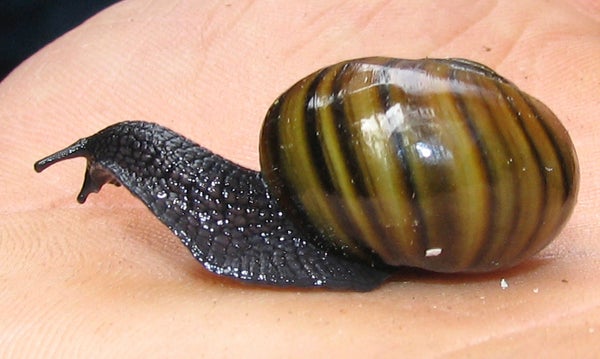This article was published in Scientific American’s former blog network and reflects the views of the author, not necessarily those of Scientific American
Ah, snails. They’re small. They’re slimy. They lack the charisma of a polar bear or a gorilla. And yet just like flora and fauna all over the world, they’re disappearing.
In Hawaii, a critically endangered snail called Achatinella fuscobasis has been brought into captivity to help learn how to keep them alive in the wild. In Alabama, conservation groups have petitioned to add the oblong rocksnail (Leptoxis compacta) to the Endangered Species List. In New Zealand, a snail known only as Rhytida oconnori has found itself constrained to a habitat just one square kilometer in size. On Fiji, scientists have expressed an “urgent need” to keep the island’s unique tree snails from going extinct. That fate may have already happened to three snail species in Malaysia after a mining company wiped out their only habitats, a series of limestone hills.
That’s just scratching the surface. By my count, nearly 140 scientific papers about endangered snails have been published so far this year.
On supporting science journalism
If you're enjoying this article, consider supporting our award-winning journalism by subscribing. By purchasing a subscription you are helping to ensure the future of impactful stories about the discoveries and ideas shaping our world today.
All of which begs the question: why does the extinction of a snail matter?
Obviously the answer to that question depends on the exact species, but we can make generalizations. Many birds, fish and other species rely on snails as important parts of their diets. Most land snail species consume fungi and leaf litter, helping with decomposition, and many are carnivores, so they help keep other species in check.
Beyond that, there’s actually a lot that we can learn from snails. “From the most practical standpoint, snails have a few pretty interesting characteristics that tell us we should probably pay attention,” says snail researcher Rebecca Rundell, assistant professor at State University of New York. For one thing, their shells—which they carry with them their entire lives (because they’d die without them)—are made of calcium carbonate, which provides a record of their lives. Unlike plant husks or insect exoskeletons, these shells tend to persist after a snail has died, leaving behind a valuable tool for researchers. “We can look in marine sediment and pockets of soil for evidence of past ecological communities, and thus evidence for environmental change in a particular area,” she says.
Living snails can also serve as indicators when something is wrong with the environment, something we’re already seeing with ocean acidification. “If snails in the ocean that make their shells, their protection, exclusively from calcium carbonate are having trouble building them, then that means the ocean is in big trouble,” Rundell says.
They can provide similar clues on land, where land snails often have particularly narrow habitat requirements. “They need certain levels of moisture, shade, and decaying matter,” Rundell says. “When they don't have this, they start dying off.” That’s just the start: if tiny land snails start to disappear, it’s important to ask what might happen next. “It might give you a chance to change course,” she says, “to detect subtle changes that humans might not otherwise be able to see until it is too late.”
Snails also help us to answer bigger questions. “The fact that many of these land snail species have small geographic ranges and that there are many species, make them fascinating subjects for learning about how life on Earth evolved,” Rundell says, adding that “scientists really rely on groups like Pacific island land snails to tell life's story.”
That opportunity, however, is at risk. “We are losing snail species at an astronomical rate,” Rundell says, “one that is equivalent to, if not exceeding, the worldwide rate of loss of amphibians.” Most species have extremely limited ranges, making them, as she puts it, “particularly susceptible to human-induced extinction.”
Meanwhile, the number of people studying snails remains relatively small. “That means we are at a big disadvantage in not only documenting land snail diversity, particularly in the tropics, but also learning from it in terms of what snails have to tell us about how life on Earth evolved,” Rundell says.
Saving snails from extinction is no easy feat. For one thing, their habitats are just too easy to destroy. For another, we don’t even know what it would take to keep most snail species alive in captivity, a function of their narrow microhabitat requirements. “One snail species might be feeding on hundreds of species of fungi that are unique to that particular forest,” Rundell says. “It is very difficult to replicate these diets in the lab.” A handful of captive-breeding efforts have been successful, but Rundell says they are labor-intensive and hard to fund.
Rundell’s own work studying Pacific island snails has shown her what it would take to reverse this snail-extinction trend. “Ultimately what is most important for land snails is the human element: people working together to protect what is most unique, precious, and irreplaceable on these islands—native forest,” she says. “This involves documenting what is there using a combination of field work and the study of natural history museum specimens. It also involves learning lessons from the past unchecked development such as agriculture and later urbanization, particularly in lowland tropical forests, and figuring out how we can protect as many pieces left as possible.” This, she says, has the “added benefit of leaving parts of the watershed, storm protection, and forest food and medicinal resources intact for people to survive in these places.”
So why does snail extinction matter? Just like everything else, snails are an important piece of the puzzle that makes this planet function. They’re also a way to help us better understand how we got here—and maybe where we’re going.
Previously in Extinction Countdown:
